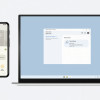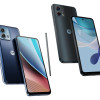Review: Palm Treo 800w
Screen
At 320 x 320 pixels, the 800w's 2.5-inch screen displays crisper and higher contrast images, videos and fonts with deeper colors than its predecessor, which has a 240 x 240 pixel screen.
As with all Windows Mobile devices, you can switch on ClearType to create smoother, more readable fonts; I don't know why ClearType is not the default setting, or why it isn't the only option, since it is make everything far easier to read. You also can enlarge the size of the font on the home screen menus including numbers being dialed, email and text messaging, but not in the Start Menu, on the icon Program and applications pages, CallerID or the dial pad, which offers pretty big buttons and numbers already. At its highest setting, the largest type setting makes text around twice the size and bolder than the default setting; why anyone would want text size smaller than the default is beyond me.
Signal
I live on the edge of Sprint's EV-DO coverage area; for instance, I get far better signal outside my northern Manhattan apartment building than inside my apartment. However, while I get only one or two bars of EV-DO signal on the Sprint Samsung Instinct, I could rely on three to a full five bars on the 800w, depending where in my apartment I wandered. While this bar difference didn't affect voice connections – I experienced only dropped call while making test calls at home and none wandering around Manhattan – data rates varied wildly as the phone dropped out of EV-DO into 1XRTT and back again depending where I wandered at home.
As with more 3G phones, it sometimes takes a minute or so to re-establish a network connection once out of a tunnel or some other long-term disconnection. The 800w was no different.
The 800w's WiFi signal was more robust and not as balky as the EV-DO alternative. It had the same range from my wireless router as an iPhone 3G.
To help you avoid drilling through menus to activate WiFi, you can turn it on and off by holding down the WiFi button on the top rim of the phone.
Sound
Unfortunately, call quality was about as consistent as my EV-DO signal. Overall voice tonal quality was above average, clear and crisp with plenty of volume, but marred by more cell warble than I expected, although this could be more the fault of local Sprint coverage than the phone.
Speakerphone volume was high and quality as clean as you could expect from a cellphone speaker, but co-conversationalists reported that I sounded as if I was talking in water. The speakerphone was full duplex, however, and had no trouble handling simultaneous conversation.
The rear placement of the speakerphone additionally strained aural comprehension. Cupping your palm around the speakerphone drastically improves the sound, but the whole idea of a speakerphone is to enable you to put the phone down on a tabletop. Placing the phone on its rear, however, covers the speaker and muffles your caller. Placing the phone front down blocks the microphone. And the rounded bottom rim of the 800w means you can't place it standing on end.
Listening to music via the speaker is more pleasurable since you are not faced with the same phone placement issues. Music sound, although mono, was loud and clean, enough to provide an adequate entertainment alternative when no other music source is available.
Ringtone and vibrate are loud and violent. I could feel the phone buzz and hear it ring in my pocket while indoors. On a noisy Manhattan street, I could rely only on the buzz to let me know a call was coming in.
Battery
Palm rates the 800w at 4.5 hours of talk time, compared with 4.7 hours on the 700w. But in our unscientific tests, with both Bluetooth and WiFi off, we never got more than 4.1 hours, and that only when the phone lapsed into a less taxing 1XRTT connection.
In multiple tests with full EV-DO connections, we got no more than three hours of consecutive talk time, results both shocking and disappointing. This is the worst disparity between a phone's rated talk time and actual results I've ever run across.
When conversation is combined with the 800w's other power-sapping attributes such as Web surfing, emailing or GPS, I find it hard to believe you'll get more than a couple of hours of talk and, if you're an active user, a nearly dead phone by mid-day.
You also get short-sheeted on standby time. Palm rates the 800w for 200 hours (8.3 days) of standby, compared to the 300 hours (12.5 days) rated for the 700w. Considering how off the talk time rating is, I can't imagine an unused 800w will remain operational uncharged for any more than around five or six days.


 iPhone 15 Series Goes All-In on USB-C and Dynamic Island
iPhone 15 Series Goes All-In on USB-C and Dynamic Island
 Samsung S24 Series Adds More AI, Updates the Hardware
Samsung S24 Series Adds More AI, Updates the Hardware
 Google Brings Nearby Share to Windows
Google Brings Nearby Share to Windows
 Motorola Updates its Most Affordable Phones
Motorola Updates its Most Affordable Phones
 Pixel 7a is a Pricey Pixel a
Pixel 7a is a Pricey Pixel a
 Palm Treo 800w
Palm Treo 800w







